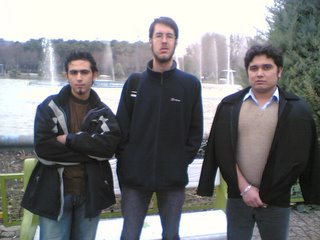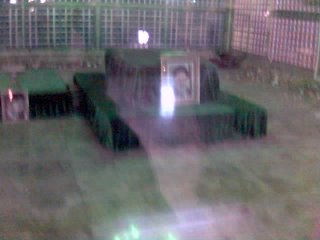







As the first significant stop on my way to Afghanistan, Iran was once-again captivating and a reminder that difference in form doesn't necessarily mean difference in quality. As the Chechen proverb goes: "the dog gave meat to the donkey, and the donkey gave hay to the dog - both went hungry. Every people likes its own customs."
This isn't to say that Iran and her people seek isolation. Quite the opposite. Young Iranians seek out western 'pop culture' in a number of shapes and forms, be it "the disco" in Dubai, trendy western-sounding Iranian pop-stars, the latest mobile phone, or even in dress-sense. Leather jackets, jeans and an 'in' hairstyle all are facets of the well-turned-out youth.
Iran is three times as big as France, and over 70 million people live within her borders. Tehran has about 16m (including outskirts). As of mid-2005 approximately two-thirds live in cities, two-thirds are under 35 years of age, and there are 8m internet users in Iran.
As regards politics, Iran is essentially a theocracy. The secular half of the government consists of an elected president and an elected parliament. It has big responsibilities but little power. The religious half of the government consists of an unelected supreme leader and an unelected guardian council. It has little responsibility but lots of power.
Recent events have kept Iran in the news. Ahmadinejad, the president, claimed that the Jewish holocaust may not have happened; it was, instead, a "myth"; he suggested that Europe should host the Jewish nation. Also smog in Tehran put over 1,600 people into hospital a week before I arrived. Tehran's location is such that the city isn't well ventilated and the systems of surrounding mountains prevent the passage of fresh air. A military plane destined for Bandar Abbas crashed into an apartment block, killing 150+ people. Needless to say, conflict continues to bubble over regarding Iran's nuclear capacities.
I stayed with some Uzbek friends of mine (originally from Afghanistan) in town, and was given a true Afghan welcome there. I stayed for a few days so as to acclimatise myself to the language, culture and temperature - much colder than a balmy twenty-degree Damascus.
First port of call, the Reza Abbasi museum. A special exhibition of 'Microcalligraphy' was on display downstairs. This consisted of trinkets containing pieces of rice with words written on them; here a Hafez poem, there a surah from the Quran. This wasn't so interesting.
Upstairs, some visible glories of old Persian culture were on display: miniatures of the 13th and 14th centuries (pictured). The manuscript illustrations range from the separate leaves from early shah-names to the album studies of the late Savafid period. I had come looking for some pictures of dancing dervishes, such as described by Sa'adi (more about him later). The pictures leap off the page, some even literally cross over the pages frame, possessing a deeply endearing larger-than-life quality. The colours of the illustrations were vividly portrayed in colour too. Many of these miniatures are housed in the US nowadays, and the collection in the museum was relatively small. Also in the museum were historical calligraphy excerpts (from the Quran etc) as well as artistic metalwork.
It was interesting to move then to the Tehran Museum of Contemporary Art (even though most of the collection on display was from the period 1977-79). Lots of paintings, along with a few sculptures. Oddly, there wasn't that much figurative art, and lots of abstract art. This I found especially noteworthy, even though the Iranian friends who accompanied me around the museum were less than excited about art that "anyone [can] do". I found myself hovering around the abstract works, almost to prove a point, even if I didn't particularly care for it.
Outside the museum, we went for a walk in a park. Parks, as far as I'm concerned, are one of the best things about Tehran. You're never far from one, and once inside you can pleasantly forget you're in the middle of a bustling capital city with heavy pollution problems. During my stay I went to three different parks (Lale, Sa'ii, and Jamshidii). Iranians like to walk in the parks at all times of day and night. Last year, after heavy snowfall, I was wandering around Jamshidii park (in a quest for a well-known Kurdish restaurant) at around 10pm only to find many families (and this includes the 4 or 5-year-olds) taking a stroll. Sa'ii park - to make a connection with my last post - even has a skating-rink, which reminded me of that in Central Park, New York. The not-so-sky-scrapers of Tehran cast a bright background. Lots of young people running around etc despite the (relatively) cold weather.
The next morning I took the metro to go see Khomeini. A strange experience partly due to segregation of sexes (not compulsory, as far as I could tell; but there were several special carriages reserved for women). However it was also jarring to travel in an underground rail carriage without any advertisements or posters whatsoever. White from tip-to-toe.
The huge site of Khomeini's grave is located in the south-west of Tehran, adjacent to the behest-e zahra cemetery, named after an epithet of Fatima, the Prophet's daughter and wife to Ali, the first Imam. Inside the mausoleum, there were forty-odd girls "praying" (as one man told me) or otherwise undergoing religious study. Khomeini's green-glass tomb-house was filled with money from well-wishers (or just simply wishers). The massive complex is still under construction, and has several domes and minarets. A shopping mall of sorts also surrounds the mosque.
The large cemetery near-by (Behest-e Zahra) is famous for two things: as a place of interment for soldiers who fought in the Iran-Iraq war, and as a cemetery for the revolutionary movement against the Pahlevi regime; many of those killed in the 1978 demonstrations were buried here (after the September 8th 1978 demonstration, over 4290 burial certificates were issued for this site). No wonder then, that this was the place Khomeini chose for his first public speech six months later. The central fountain once ran with blood-red coloured water to symbolise the loss of Iran during the Iran-Iraq war. Wandering around the cramped burial quarters, the faces of many young men stared out, as if to challenge me.
I spent an enjoyable couple of hours then wandering in the old bazaar of Tehran, and eating 'traditional' Persian food in an old restaurant with Behrouz and Miilat, my Iranian-Afghan-Uzbek friends and hosts. All that was left was for me to find a farsi-language copy of Sa'adi's Golestan, a collection of poems and stories and a classic of Persian literature. This would accompany me on my travels in Afghanistan, I hoped. As a little taster for his humour and wisdom side by side, here are two stories:
[1st story]: A padshah [kind of king] was in the same boat with a Persian slave who had never before been at sea and experienced the inconvenience of a vessel. He began to cry and to tremble to such a degree that he could not be pacified by kindness, so that at last the king became displeased as the matter could not be remedied. In that boat there happened to be a philosopher, who said: 'With thy permission I shall quiet him.' The padshah replied: 'It will be a great favour.' The philosopher ordered the slave to be thrown into the water so that he swallowed some of it, whereon he was caught and pulled by his hair to the boat, to the stern of which he clung with both his hands. Then he sat down in a corner and became quiet. This appeared strange to the king who knew not what wisdom there was in the proceeding and asked for it. The philosopher replied: 'Before he had tasted the calamity of being drowned, he knew not the safety of the boat; thus also a man does not appreciate the value of immunity from a misfortune until it has befallen him.'
[Second story, illustrating the maxim that love means continuing to care after hope has gone]: "Once upon a time there was a woman who had three suitors. Before she could choose between them, she fell ill and died. One of the young men wandered the world, vowing to find a way to bring her back to life. The second spent his time comforting her aged father. The last threw himself on her grave and refused to budge.
It so happened that the wandering suitor rescued a wise man who had fallen down a well. The sage knew how to make an ointment that could bring the dead to life. However, he required the root of a particular tree, which was guarded by a ferocious monster. The young man vanquished the monster and got hold of the root; the ointment was prepared. When it was rubbed on to the woman's corpse, she was restored to life.
All the suitors began to pester the lady for her hand. 'I was a comfort to your father in his sorrow,' said the first young man. 'I lay by your grave, pining away with love,' said the second. 'But it was I who found the ointment that saved you,' said the third.
The woman said: 'The suitor who looked after my father was a son for him. The one who found the ointment is a humanitarian. But the man who lay weeping upon my grave after all hope had died, he is the one who behaved like a lover and I shall marry none but him.'"
Mashhad (in the east) is one of the next cities (after Tehran) of comparable size, at 2m inhabitants. I took the bus from Tehran to Mashhad and jumped straight on a bus to Herat. This journey of 23-hours and over 800 miles cost me around $5 or £2.50. I finished Karen Armstrong's A Short History of Myth as well as Tolstoy's Hadji Murat [less impressive than I'd expected...]. I'm rereading Karen Armstrong's biography of Muhammad at the moment, as well as dipping into Sa'adi's Golestan here and there. Will travel to Kandahar (south Afghanistan) on Thursday morning probably.

0 Comments:
Post a Comment
<< Home